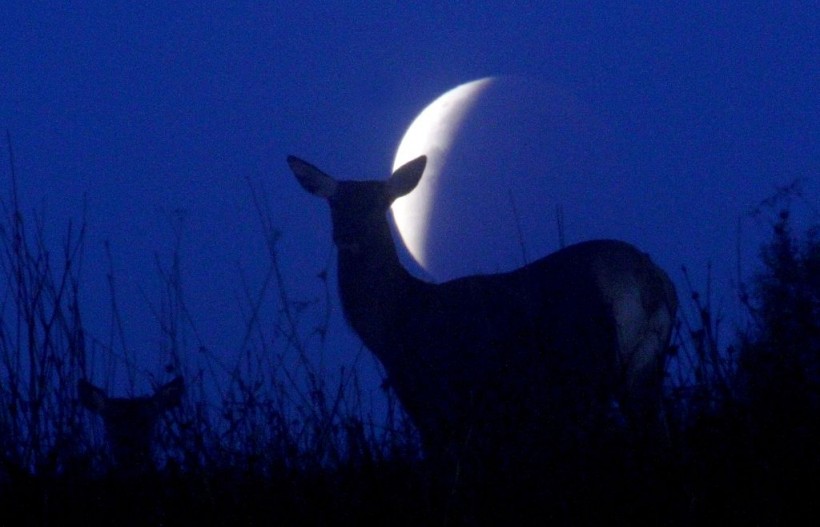A recent study shows that the moon's crust may have developed due to a 'slushy' lava ocean that froze over hundreds of millions of years.
It's the latest twist in scientists' understanding of how the moon and its characteristics developed, a picture that's been evolving since Apollo astronauts returned to Earth with moon rocks in the late 1960s and early 1970s.
The findings were published in the journal Geophysical Research Letters under "Formation of the Lunar Primary Crust From a Long-Lived Slushy Magma Ocean."

Reindeer are seen silhouetted against the moon during a lunar eclipse near the village of Yavterishki, some 250 kilometers north from Minsk on September 28, 2015. The combination of a supermoon and total lunar eclipse last occurred in 1982 and will not happen again until 2033.
Moon's Crust Might Have Originated From a 'Slushy' Lava Ocean
A multinational team of scientists led by the University of Cambridge developed a set of computer and mathematical models to investigate the chemical makeup and behavior of moon rocks and how they may interact in the early 'liquid magma' moon.
They discovered that when the moon cooled following its initial explosive start, a frozen sea of molten rock might have formed, eventually leading to the current lunar surface.
The moon's crust may have developed like crystals in a slushy machine before remaining suspended in liquid magma for hundreds of millions of years while the young moon's 'slush' froze and hardened, according to the researchers.
If the crystals remain suspended in a slurry, the slurry becomes thick and sticky when the crystal content surpasses a critical threshold.
ALSO READ: Unlocking the Moon's Magnetic Mystery: New Study Reveals Traces of the Half-Century Enigma
The slushy magma ocean cools at the surface, resulting in a hot, well-mixed slushy interior and a slow-moving, crystal-rich lunar 'lid' - forming the lunar surface.
Study co-author Chloé Michaut, a volcanologist at the ENS de Lyon in France, said in a statement that this' flotation' scenario explains how the lunar highlands may have developed.
Further examination of lunar samples has revealed that the anorthosites are more varied than the Apollo samples, contradicting previous assumptions about how the crust evolved.
Professor Jerome Neufeld of the Department of Applied Mathematics and Theoretical Physics at the University of Cambridge collaborated with Michaut to construct a mathematical model to discover this process.
According to the researchers, the early magma ocean's cooling caused such intense convection that crystals stayed suspended as a slurry, similar to those in a slushy machine.
However, Space.com noted a flaw in that image: the time was off. For 100 million years, the surface of a global magma ocean should have cooled and hardened. They discovered that the anorthosites had a twice-as-large age range when scientists looked again.
Moon Trips
The announcement comes when there is increasing enthusiasm for returning to the moon. NASA's request for future lunar landings is backed by scientists from The Open University.
ITV said the OU has joined up with NASA Goddard Spaceflight Center and with the European Space Agency to create an instrument that will monitor the moon's fragile atmosphere near the surface as part of NASA's Artemis mission.
Artemis is a long-term project aimed at establishing a livable moonbase. It is envisioned that it will serve as a base for crewed trips to Mars.
The Chinese space agency successfully landed a rover on the moon's surface in 2019. It captured footage of the moon's far side. The images revealed the Jade Rabbit 2 rover and the Chang'e 4 spacecraft that took it to the moon's far side, which is constantly facing away from Earth, for the first soft landing.
RELATED ARTICLE: NASA Mission: Apollo 17 Rock Sample Troctolite 76535 Shows Moon Is Cooler Than Everyone Thought
Check out more news and information on Space in Science Times.














